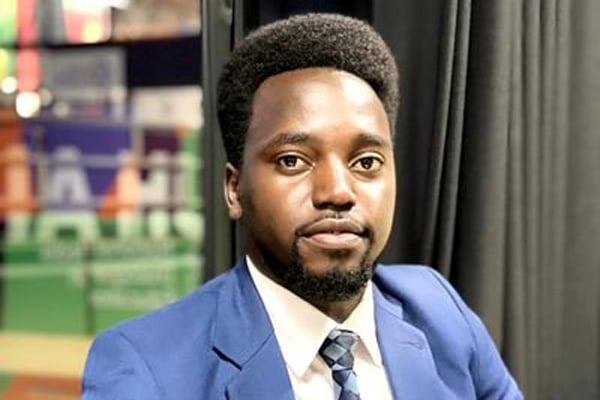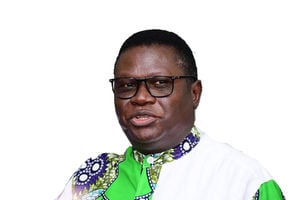
A man injects a colleague with a drug. Experts say drug addiction usually starts with the noble aspiration to ease pain. PHOTO/DAILY NATION
|National
Prime
Inside Uganda’s new drug crisis
What you need to know:
- Five of 15 people who, on average, check into Butabika National Referral Mental Hospital’s alcohol and drug unit each month, grapple with some form of opioid addiction.
The face of opioid-related overdoses in Uganda wears a white lab coat and has a stethoscope hugging their neck, an investigation by Monitor can reveal.
Five of 15 people who, on average, check into Butabika National Referral Mental Hospital’s alcohol and drug unit each month, grapple with some form of opioid addiction.
An opioid is a compound whose addictive properties or physiological effects resemble those of opium.
Opioids—medically called prescription opioids—are, therefore, controlled substances used to treat moderate to severe pain. Their addiction is termed opioid use disorder.
Experts Monitor spoke to indicated that rehabilitation or rehab facilities dotting the country have a sizeable number of medical doctors battling over prescription of legal pain medications. At Butabika, a staggering 90 percent of the opioid addicts who check into rehab each month are medical doctors.
Dr Byamah Mutamba, a senior consultant psychiatrist, who heads the alcohol and drug unit at Butabika, says anecdotal evidence suggests that stigma bars doctors battling opioid use disorder from seeking help.
The drug addiction usually starts with the noble aspiration to ease pain. Take Ms Jackie Chandiru, a local songstress, who after suffering chronic back pain, was prescribed pethidine—a pain relief drug. Being a performer, the pain in her lower back kept recurring every time she performed. This bred an addiction to a prescription drug that not only eased the pain but also put Ms Chandiru in a “zone” of rest.
“When administered, this severe pain medicine will easily control the pain but give effects that make one more addicted to it,” Dr Mutamba said in an interview on Tuesday.
Knowing that the drug had various side effects, including a possibility of addiction by the user, Ms Chandiru’s doctor had refused to give her more prescriptions. She, however, used her financial muscle to access pethidine and would administer it to herself without prescription. She did repeatedly to the point of being hooked.
“Every time I woke up, I would not desire food but the drug,” Ms Chandiru, who walked the road from addiction to recovery, told Monitor.
The vast majority of opioid addicts who check into Butabika are hooked onto the pain relief drug that once was Ms Chandiru’s Achilles’ heel—pethidine. A growing number also use tramadol as per Dr Mutamba.
Black market
Although prescription pain relief drugs are not supposed to be accessed over the counter with absurd ease, they are readily accessible by either drug dealers or unsupervised medical outlets without the right professionals.
“Anyone who knows the danger of these medications cannot give them like they are giving Panadol because they need a well detailed prescription. Unfortunately, because they are drugs of abuse, they are on the black market” Dr Mutamba revealed.
At Safe Places Uganda—a mental health hospital and rehabilitation centre where a quarter of her patients are battling opioid use disorder—psychologist Janet Kantalama has noticed a pattern emerge. Most of the opioid addicts—much like Ms Chandiru—initially were seeking medicine for the relief of chronic pain. She admits that there are loopholes in Uganda’s medical system that have been ruthlessly exploited.
Ms Kantalama told Monitor that opioid addicts who walk into Safe Places Uganda are youth, whose abodes are poor urban areas or ghettos. They ‘punch’ cough syrups with opioid medications like morphine from which they derive codeine and heroin.
Although responsible authorities opted not to share statistics that sketch the portrait of Uganda’s opioids addiction problem, anecdotal evidence indicates that there has been a spike in cases. Synthetic opioids like fentanyl are, especially, popular among the rich urban youths.
Uganda’s poorly paid medical workers have also been tempted to dip their hands in the cookie jar to cash in on paydays from the black market.
Synthetic Opioids are chemically created in laboratories and act on the same targets in the brain as natural opioids like morphine and codeine, which are from poppy plants.
Mr Charles Ssenabulya, an addiction counsellor at Hope and Beyond Rehabilitation Centre in the Kampala suburb of Wakaliga, says the troubling picture that has started to emerge owes to the fact that there is more awareness and uptake about the drugs today than in the past. People know which synthetic opioids can put them in the “zone” that Ms Chandiru described. The forces driving accessibility of the pain relief drugs on the black market have also not helped matters.
About the telltale signs of opioid users, Dr Mutamba says there is usually a noticeable change in their behaviour. Their health also deteriorates, Dr Mutamba adds, because the dosage they rely on is not medically guided. Dr Mutamba advises one to seek appropriate services once they notice that someone entrusted to their care is using opioids.
“Trained professionals know how to deal with these addicts and know how better to support them on their way to recovery,” he says.
Journey to recovery
At Butabika, the alcohol and drugs unit has a medication assisted treatment (MAT) clinic where people come in daily and receive safer supervised opioids.
Although the clinics mainly target users of illicit opioids like heroin, they also cater to victims of prescribed opioids like pethidine and tramadol.
Dr Mutamba explains that the safer supervised opioids are designed to eventually stop users from turning to dangerous unprescribed opioids.
According to Ms Kantalama, people who have used opioids and recovered should avoid the company of people, friends and other environs that remind them of their addictive past.
“Addiction in its own self is a disease,” she says rather bluntly, adding, “There is a memory in relation to the feeling a recovering addict gets each time they associate with people or environments that they lived in during their time of addiction.”
She further notes that spaces of a kind and the people might trigger an element of powerlessness that can draw someone back into drug usage. Her counsel to recovering addicts is to try and adopt new lifestyles that equally give them new experiences. These eventually make them forget the virtual good feeling that opioids gave them. Games and gyms are—in Ms Kantalama’s book—a great recommendation.
Ms Chandiru last month performed at the Miss Uganda beauty paegent. It was the second big event she was performing at after being a curtain raiser at Jose Chameleone’s Gwanga Mujje concert. The 38-year-old recovering addict said she suffered stage fright, but eventually overcame it to cover herself in glory.
The most abused opioids in Uganda
Pethidine
Synthesised in 1938, this opioid pain medication can be used for the treatment of moderate to severe pain. Statistics show that it was the opioid of choice for many physicians during the 20th century. It was mostly prescribed for acute pain and chronic severe pain. It remains the preferred opioid for use during labour and delivery in many countries.
Tramadol
Oral or injectable, pain relief usually commences within an hour when taken by mouth. The 35th most commonly prescribed medication in the United States, it had nearly 18 million prescriptions under its belt in the country in 2020. Its pain reducing effects last nearly six hours. Sleep medicine physicians at times prescribe it.
Opioid addict telltale signs
Ms Janet Kantalama, a psychologist at Safe Places Uganda, says many opioid users usually start excluding themselves from others. She adds that they become moody and are easy to anger.
Another noticeable element as per Ms Kantalama is their burning desire for money. Most users resort to borrowing to prop their addiction. Some of the “innocent” drugs that contain opioids include paracetamol and some cough syrups that contain codeine.
What the National Drug Authority says
Given the risks associated, drugs are classified into prescription, pharmacist-initiated and over-the-counter drugs.
In Uganda, drugs are specifically classified in one of six classes, including Class A, Class B -Group 1, Class B Group 2, Class C – Group 1 and Class C – Group 2. Class A & Class B Group 1 are prescription-only medicines, which should be accessed with a prescription of a medical practitioner, dentist or veterinary surgeon.
Class B (Group 2) are pharmacist-initiated drugs, which can be issued by a pharmacist without a need for prescription, while Class C are off-counter drugs and these can be dispensed by a pharmacist or licensed seller without a prescription. These classifications are available on the NDA website.
The model of separation of prescription and dispensing assumes that the patient first sees a clinician before they access medicines. Unfortunately, access to medicine is heavily dependent on model of payment. It is estimated that close to 70 percent of people in developing countries pay for their health out of pocket.
This means for the majority of people, their treatment decision is driven by the ability to pay for their medical needs. In some unfortunate cases, some people negotiate to take only the drug they can pay for instead of a full dose!
As a regulator, we cannot fully wipe out drug dealing because like any other crime, there is a benefit to it by the culprits.
Drugs on the black market is a global concern. As a regulator, we put mechanisms to control this but people will always find a way. Our enforcement with Uganda Revenue Authority shows that some people try to smuggle in drugs at the airport, some trailers are caught with drugs too.
Although we put mechanisms, the people beating the system do not follow them. What we keep doing is empowering and sensitising communities where they should get the drugs.





